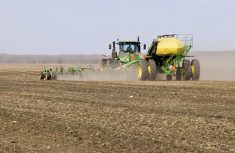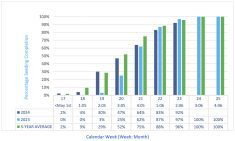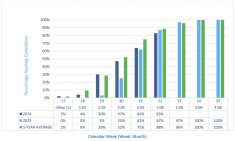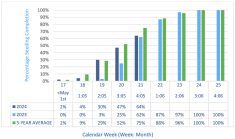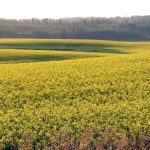Overview
Soybean aphids are reaching economic thresholds in scattered locations across Manitoba. Spraying is occurring as-needed, but crops require intensive scouting on a field-by-field basis.
Grasshopper pest species are present in all regions – mostly confined to field edges and headlands but moving more as insects reach adult (winged) stages and travel further into fields. Feeding damage varies, and control is ongoing as required.
Read Also

A place of national honour for former deputy ag minister, Dori Gingera-Beauchemin
Long public service, focus on community and industry leadership launch Dori Gingera-Beauchemin into 2025 Canadian Agricultural Hall of Fame honourees
Some crop protection companies are closely watching local insecticide supplies, as supply chain issues persist and increased demand has stretched supplies.
The Manitoba Crop Pest Update publishes detailed information each Wednesday on insect, disease and weed issues in the province.
The Manitoba Hay Listing Service is active; producers with extra feed or looking for feed are encouraged to list their available supplies for sale.
Cereals
Small grains
Spring cereal crop flowering is complete, and kernel development is reaching soft to hard dough in most locations. The spring wheat crop is rated mostly good to excellent, with some exceptions due to extreme moisture.
Barley crops range milky to soft dough stages, with malt crops most advanced, and greenfeed or very late-seeded fields further behind.
Oat crops are reaching hard dough in the most advanced fields, head glumes are starting to turn colour.
Oat-birdcherry and English grain aphids are noticeable in a number of oat fields, mostly found on the undersides of the flag leaf. Populations are being monitored, and some spraying has occurred where thresholds (12-15 aphids/stem prior to soft dough) are reached.
High levels of beneficial insect parasitism of aphids has been observed in many crops this year.
Fall rye is rapidly turning colour, with a limited start to harvest near Morden and Manitou. Many fields are being swathed this week in the Central and Southwest regions.
Winter wheat has reached physiological maturity. Pre-harvest aid application is underway or complete, and harvest has started in the Eastern region.
Corn
Corn development ranges from R2 (blister stage) to R3 (milk stage). Rapid dry matter accumulation is beginning, and nutrient demand will be highest in the next 30 to 40 days.
Silks are generally dry and dropping off in most fields, seed set evaluation is ongoing.
Oilseeds
Canola crops are variable across Manitoba, with some in excellent condition and others in poor condition with thin stands. Flowering ranges from the mid-bloom to fully podded (BBCH 65 to 78).
Early crops have podded up well, with limited heat blast and flower abortion this year, and producers are watching crop development closely.
Flax crops are nearly done flowering, boll development looks good and disease issues are limited. Flowering appeared to be somewhat extended after rainfall and cooler conditions encouraged more blooms following a week of very high temperatures.
Sunflowers are at the R4 to R5.9 stages, with many flowers opening this past week on the most advanced fields. Fungicide and/or insecticide application for grasshoppers in sunflowers is ongoing.
Sclerotinia basal rot/stem canker is common in sunflower fields, and will lead to greater lodging risk at harvest and significantly reduced yields on infected plants.
Pulses
Soybeans have closed rows and have reached the R4 to R5 stages. Crop development has moved very quickly, almost at ‘normal’ for the time of year.
Scattered reports of soybean aphids in all regions, with a few fields exceeding economic action threshold levels, and spraying in the Eastern (Beausejour to Lac du Bonnet) and Central (Carman) regions. Growers have asked for Sefina insecticide, but supplies are very limited, and are resorting to a pyrethroid product for control.
Soybean aphid numbers vary widely, and crops need to be scouted on a field-by-field basis.
Grasshopper feeding in soybeans is increasing, as they move out of cereal crops and ditches. Control has been warranted in some areas.
The majority of field peas have finished flowering, and are filling pods (R4). Earlier seeded fields are turning colour, but there have been no reports of desiccation to date.
Excess rainfall has led to root rot in poorly drained fields or areas of fields. Yellow areas are evident in low spots and drains. Patchy maturity is expected in these fields.
Dry beans range from R4 to R6 stages. Fields are starting to see yellow leaves in the lower canopy, and
most fields are quite clean, with good weed control this year.
Forages & Livestock
Forages
More hay has been harvested as round bale silage than normal due to wet weather, but recent hay quality has improved with drier days.
Dairy farms are about 70 per cent finished second-cut hay, while beef cattle producers are starting as haying weather improves.
Yields in the Southwest region have been reported as 4 bales/acre in grass stands, and 5 to 6 bales/acre in alfalfa.
Wild (native) hay fields are wet, and harvest will be limited unless it dries up. Livestock
Pasture growth has slowed, as expected for mid-summer and cattle feed supplies are adequate.
Dugouts and sloughs are at 90 per cent capacity, while creek and stream flows have slowed.
Livestock water supplies remain sufficient.
Regional comments
Southwest
Cooler days and dry weather arrived this week, favouring an extended canola flowering period. No damaging winds or hail caused crop injury in the region in the past seven days, and a band from Hamiota to Carberry saw rains up to 15 mm. A few locations are in need of rain, where crops on well drained, sandy soils are showing minor water deficiency symptoms and have remained dry for the past several weeks. Pivot irrigation is ongoing in potatoes and some other crops where infrastructure allows.
Northwest
A mix of temperatures and precipitation this week with day time temps reaching nearly 30 C and overnight lows dipping down well below 10 C; a cool -1.6 C was reported at the Swan Valley station for a very brief period. Winds were persistently strong for several days last week. Minimal precipitation fell in most of the region, with the exception of Birch River (18mm) and The Pas (35.5 mm). Precipitation would benefit some areas of the region.
Previously lodged wheat and barley have recovered somewhat, but many areas remain quite flat. Silage corn fields are beginning to tassel and silaging will start soon. Greenfeed cutting has begun.
Central
Temperatures have cooled to seasonal normal, with overnight lows dropping to single-digits which has concerned some farmers. However, cool nights have favoured canola flowering and seed development and crops appear in good condition throughout most of the region. Lodged cereals have recovered somewhat, with cereals bouncing back better than lodged canola. Approximately 10% of first-cut hay was not baled due to repeated rains and wet weather.
Eastern
Rainfall accumulations ranged from trace amounts to around 20 mm. Areas that had rainfall received the majority of it last Tuesday as a series of storms, as unsettled weather came to an end. The remainder of the week was relatively dry, except for the occasional isolated rain shower or thunderstorm. Temperatures were highly variable with both above and below seasonal daytime highs. The past weekend saw particularly cool conditions during the overnight periods, with high humidity. With the relative lack of rain, field access generally improved.
Interlake
Fall rye swathing has started this week, while canola staging ranges from 50 per cent bloom to podding. Grasshopper spraying on cereal field headlands is occurring where pressure justifies application. Haying continues with good yields, however recent rains have lowered the quality of the hay. Crops appear in good condition in southern parts of the region, where they haven’t drowned out. Northern parts of the region have highly variable crops and crop condition.







